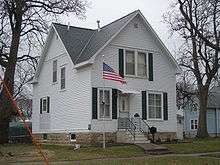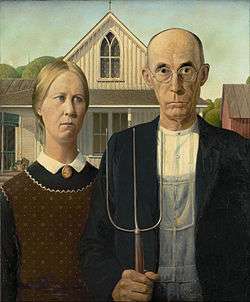Grant Wood
| Grant Wood | |
|---|---|
 Self-portrait, 1932 | |
| Born |
Grant DeVolson Wood February 13, 1891 Anamosa, Iowa |
| Died |
February 13, 1942 (aged 51) Iowa City, Iowa |
| Nationality | American |
| Education | School of the Art Institute of Chicago |
| Known for | Painting |
| Notable work | American Gothic |
| Movement | Regionalism |
Grant DeVolson Wood (February 13, 1891 – February 13, 1942) was an American painter best known for his paintings depicting the rural American Midwest, particularly American Gothic, an iconic painting of the 20th century.[1][2]
Life and career

Grant Wood was born in rural Iowa four miles (6 km) east of Anamosa in 1891; his mother moved the family to Cedar Rapids after his father died in 1901. Soon thereafter he began as an apprentice in a local metal shop. After graduating from Washington High School, Wood enrolled in The Handicraft Guild, an art school run entirely by women in Minneapolis in 1910 (today it is a prominent artist collective in the city.) He was said to have later returned to the Guild to paint American Gothic. A year later Wood returned to Iowa, where he taught in a rural one-room schoolhouse.[4] In 1913 he enrolled at the School of the Art Institute of Chicago and performed some work as a silversmith.
From 1922 to 1928, Wood made four trips to Europe, where he studied many styles of painting, especially Impressionism and Post-Impressionism. But it was the work of the 15th-century Flemish artist Jan van Eyck that influenced him to take on the clarity of this technique and to incorporate it in his new works.
From 1924 to 1935, Wood lived in the loft of a carriage house in Cedar Rapids, which he turned into his personal studio at "5 Turner Alley" (the studio had no address until Wood made one up). In 1932, Wood helped found the Stone City Art Colony near his hometown to help artists get through the Great Depression. He became a great proponent of regionalism in the arts, lecturing throughout the country on the topic.[5] As his classically American image was solidified, his bohemian days in Paris were expunged from his public image.[6]
Wood was married to Sara Sherman Maxon from 1935–38. She was considerably older and friends considered the marriage a mistake for him.[7] Wood taught painting at the University of Iowa's School of Art from 1934 to 1941. During that time, he supervised mural painting projects, mentored students, produced a variety of his own works, and became a key part of the University's cultural community. It is thought that he was a closeted homosexual, and that there was an attempt to fire him because of a relationship with his personal secretary. Critic Janet Maslin states that his friends knew him to be "homosexual and a bit facetious in his masquerade as an overall-clad farm boy".[8] University administration dismissed the allegations and Wood would have returned as professor if not for his growing health problems.[9] In the early hours of February 13, 1942, his 51st birthday, Wood died at the university hospital of pancreatic cancer.[10] When Wood died, his estate went to his sister, Nan Wood Graham, the woman portrayed in American Gothic. When she died in 1990, her estate, along with Wood's personal effects and various works of art, became the property of the Figge Art Museum in Davenport, Iowa.
Work
Wood was an active painter from an extremely young age until his death, and although he is best known for his paintings, he worked in a large number of media, including lithography, ink, charcoal, ceramics, metal, wood and found objects.

Throughout his life, he hired out his talents to many Iowa-based businesses as a steady source of income. This included painting advertisements, sketching rooms of a mortuary house for promotional flyers and, in one case, designing the corn-themed decor (including chandelier) for the dining room of a hotel. In addition, his 1928 trip to Munich was to oversee the making of the stained glass windows[4] he had designed for a Veterans Memorial Building in Cedar Rapids. The window was damaged during the 2008 flood and it is currently in the process of restoration.[11] He again returned to Cedar Rapids to teach Junior High students after serving in the army as a camouflage painter.
Regionalism
Wood is associated with the American movement of Regionalism that was primarily situated in the Midwest, and advanced figurative painting of rural American themes in an aggressive rejection of European abstraction.[12]
Wood was one of three artists most associated with the movement. The others, John Steuart Curry and Thomas Hart Benton, returned to the Midwest in the 1930s due to Wood's encouragement and assistance with locating teaching positions for them at colleges in the states of Wisconsin and Missouri, respectively. Along with Benton, Curry, and other Regionalist artists, Wood's work was marketed through Associated American Artists in New York for many years. Wood is considered the patron artist of Cedar Rapids, and his childhood country school is depicted on the 2004 Iowa State Quarter.
American Gothic

Wood's best known work is his 1930 painting American Gothic,[13] which is also one of the most famous paintings in American art,[12] and one of the few images to reach the status of widely recognised cultural icon, comparable to Leonardo da Vinci's Mona Lisa and Edvard Munch's The Scream.[1]
It was first exhibited in 1930 at the Art Institute of Chicago, where it is still located. It was given a $300 prize and made news stories country-wide, bringing Wood immediate recognition. Since then, it has been borrowed and satirized endlessly[12] for advertisements and cartoons.[13]
Art critics who had favorable opinions about the painting, such as Gertrude Stein and Christopher Morley, assumed the painting was meant to be a satire of repression and narrow-mindedness of rural small-town life. It was seen as part of the trend toward increasingly critical depictions of rural America, along the lines of Sherwood Anderson's 1919 Winesburg, Ohio, Sinclair Lewis' 1920 Main Street, and Carl Van Vechten's The Tattooed Countess in literature.[1][12] Wood rejected this reading of it.[12] With the onset of the Great Depression, it came to be seen as a depiction of steadfast American pioneer spirit.[13] Another reading is that it is an ambiguous fusion of reverence and parody.[12]
Wood's inspiration came from Eldon, southern Iowa, where a cottage designed in the Gothic Revival style with an upper window in the shape of a medieval pointed arch, provided the background and also the painting's title.[12] Wood decided to paint the house along with "the kind of people I fancied should live in that house."[1] The painting shows a farmer standing beside his spinster daughter, figures modeled by the artist's dentist and sister, Nan (1900–1990).[12] Wood's sister insisted that the painting depicts the farmer's daughter and not wife, disliking suggestions it was the farmer's wife, since that would mean that she looks older than Wood's sister preferred to think of herself. The dentist, Dr. Byron McKeeby (1867–1950) was from Cedar Rapids, Iowa. The woman is dressed in a dark print apron mimicking 19th century Americana with a cameo brooch and a tightly-knotted tie, and the couple are in the traditional roles of men and women, the man's pitchfork symbolizing hard labor.
The compositional severity and detailed technique derive from Northern Renaissance paintings, which Grant had looked at during three visits to Europe; after this he became increasingly aware of the Midwest's own legacy, which also informs the work. It is a key image of Regionalism.[12]
Wood was hired in 1940, along with eight other prominent American artists, to document and interpret dramatic scenes and characters during the production of the film The Long Voyage Home, a cinematic adaptation of Eugene O'Neill's plays.[14]
Works by Wood
Pages
- American Gothic (1930)
- Appraisal (1931)
- Arbor Day (1932)
- Arnold Comes of Age (1930)
- The Birthplace of Herbert Hoover, West Branch, Iowa (1931)
- Boy Milking Cow (1932)
- Daughters of Revolution (1932)
- Death on Ridge Road (1935)
- Dinner for Threshers (1934)
- Fall Plowing (1931)
- Haying (1939)
- Iowa Cornfield (1941)
- January (1940)
- The Little Chapel Chancelade (1926)
- The Midnight Ride of Paul Revere (1931)
- Near Sundown (1933)
- New Road (1939)
- Parson Weems' Fable (1939)
- Plaid Sweater (1931)
- Portrait of Nan (1933)
- Return from Bohemia (1935)
- Seedtime and Harvest (1937)
- Self-Portrait (1932)
- Spotted Man (1924)
- Spring in the Country (1941)
- Stone City, Iowa (1930)
- Sultry Night (1937)
- Woman with Plants (1929)
- Young Corn (1931)
Writing
- Wood, Grant. "Art in the Daily Life of the Child." Rural America, March 1940, 7–9.
- Revolt against the City. Iowa City: Clio Press, 1935.
Secondary literature
- Corn, Wanda M. Grant Wood: The Regionalist Vision. New Haven: Minneapolis Institute of Arts and Yale University Press, 1983.
- Crowe, David. "Illustration as Interpretation: Grant Wood's 'New Deal' Reading of Sinclair Lewis's Main Street." In Sinclair Lewis at 100: Papers Presented at a Centennial Conference, edited by Michael Connaughton, 95–111. St. Cloud, MN: St. Cloud State University, 1985.
- Czestochowski, Joseph S. John Steuart Curry and Grant Wood: A Portrait of Rural America. Columbia: University of Missouri Press and Cedar Rapids Art Association, 1981.
- DeLong, Lea Rosson. Grant Wood's Main Street: Art, Literature and the American Midwest. Ames: Exhibition catalog from the Brunnier Art Museum at Iowa State University, 2004.
- When Tillage Begins, Other Arts Follow: Grant Wood and Christian Petersen Murals. Ames: Exhibition catalog from the Brunnier Art Museum at Iowa State University, 2006.
- Dennis, James M. Grant Wood: A Study in American Art and Culture. New York: Viking Press, 1975.
- Renegade Regionalists: The Modern Independence of Grant Wood, Thomas Hart Benton, and John Steuart Curry. Madison: University of Wisconsin Press, 1998.
- Evans, R. Tripp. Grant Wood [A Life]. New York: Alfred A. Knopf, 2010 OCLC 503041934.
- Graham, Nan Wood, John Zug, and Julie Jensen McDonald. My Brother, Grant Wood. Iowa City: State Historical Society of Iowa, 1993.
- Green, Edwin B. A Grant Wood Sampler, January Issue of the Palimpsest. Iowa City: State Historical Society of Iowa, 1972.
- Haven, Janet. "Going Back to Iowa: The World of Grant Wood", MA project in conjunction with the Museum for American Studies of the American Studies Program at the University of Virginia, 1998; includes list of paintings and gallery.
- Hoving, Thomas. American Gothic: The Biography of Grant Wood's American Masterpiece. New York: Chamberlain Brothers, 2005.
- Milosch, Jane C., ed. Grant Wood’s Studio: Birthplace of American Gothic. Cedar Rapids and New York: Cedar Rapids Museum of Art and Prestel, 2005.
- Seery, John E. "Grant Wood's Political Gothic." Theory & Event 2, no. 1 (1998).
- Taylor, Sue. "Grant Wood's Family Album." American Art 19, no. 2 (2005): 48–67.
References
- 1 2 3 4 Fineman, Mia, The Most Famous Farm Couple in the World: Why American Gothic still fascinates., Slate, 8 June 2005
- ↑ Oxford Index
- ↑ Preservation Iowa, 2008 Most Endangered Properties Archived January 5, 2016, at the Wayback Machine.
- 1 2 "Grant Wood", answers.com
- ↑ http://www.artnet.com/Galleries/Artists_detail.asp?gid=267&aid=18073
- ↑ Maslin, Janet Behind That Humble Pitchfork, a Complex Artist, In "Grant Wood", R. Tripp Evans Explores the Artist. New York Times, 3 Oct 3, 2010.
- ↑ Chicago Tribune, Review of R Tripp Evan, Grant Wood, A Life
- ↑ Maslin, Janet Behind That Humble Pitchfork, a Complex Artist, In "Grant Wood", R. Tripp Evans Explores the Artist. Books of the Times, The New York Times, Oct 3, 2010.
- ↑ The Chronicle of Higher Education
- ↑ Deborah Solomon (October 28, 2010). "Gothic American". The New York Times.
- ↑ http://www.gazetteonline.com/apps/pbcs.dll/article?Date=20090118&Category=NEWS&ArtNo=701189924&Template=printart
- 1 2 3 4 5 6 7 8 9 "Grant Wood", Art Institute of Chicago. Retrieved December 14, 2008.
- 1 2 3 Kendall, Sue M., "Wood, Grant", Oxford Art Online (subscription). Retrieved 14 December 2008.
- ↑ "Cover Article, American Artist Magazine, September, 1940, pp. 4-14"
External links
- http://www.usa-decouverte.com/culture/magazine/grant_wood.html
- Grant Wood Archive, Figge Art Museum
- Grant Wood scrapbooks, Iowa Digital Library
- Cedar Rapids Museum of Art biography of Grant Wood
- Grant Wood on artcyclopedia.com
- Grant Wood and Frank Lloyd Wright Compared
- American Classic: Grant Wood and the meaning of his art
- Grant Wood's Studio
- Ten Dreams Galleries
- Grant Wood Gallery at MuseumSyndicate
- Grant Wood Papers Online at the Smithsonian Archives of American Art
- The Long Voyage Home Artist Portraits and Paintings at The Ned Scott Archive
- "Grant Woods Murals in the Parks Library at Iowa State University"
- "When Tillage Begins"
- "Breaking the Prairie Sod"
- "History of Dairying"
- http://www.usa-decouverte.com/culture/magazine/grant_wood.html article by André Girod